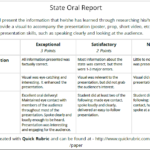What is their purpose?
Rubrics define what faculty consider to be exceptional work, satisfactory work, unsatisfactory work for a given submission and which criteria are evaluated to make those distinctions. Clear communication is an essential component of online programs; clear assessment descriptions and rubrics can help eliminate questions and confusion.
How can I use them?
Because faculty prepare rubrics to communicate their expectations to you, the student, you should always refer to the rubric for a given assessment before you begin working on it. The rubric, along with the instructions, tells you what to focus on as you work. This is especially important in a program like UW Flexible Option, where you direct your own learning more so than in a traditional classroom. You are empowered as a learner when you use the rubric to prepare your assessment.

You should also refer to the rubric before submitting your work for evaluation. This gives you a chance to reflect on and assess the quality of your own work before submitting it.
After your assessment has been evaluated, you will receive feedback from a Flexible Option faculty member based on the rubric. This feedback, in conjunction with the rubric, will help you recognize strengths and weaknesses within this assessment and identify areas needing development in future assessments.
Where do I find them?
Look for rubrics with the assessment instructions. They are often referred to as “Evaluation Criteria.”
How do faculty use them?
Rubrics help faculty evaluate assessments more efficiently and objectively. They also make grading less subjective, so scores are consistently applied across students even when more than one instructor is involved in the evaluation process. Consistent evaluation is a critical component to administering competency-based education programs like Flex.
Ultimately, rubrics serve as a type of informal contract between students and faculty. Faculty communicate that if your work demonstrates “x” characteristics, then you will receive a “y” score. This approach shifts the conversation away from the idea of faculty “giving” points and toward the idea of students earning points based on the objective criteria provided in the rubric.
